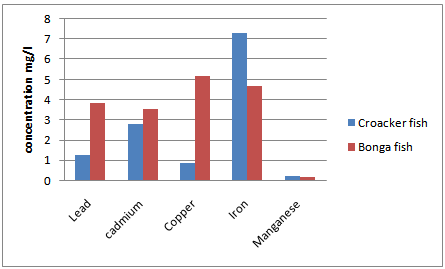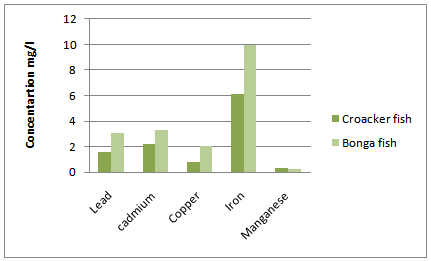-
Paper Information
- Next Paper
- Previous Paper
- Paper Submission
-
Journal Information
- About This Journal
- Editorial Board
- Current Issue
- Archive
- Author Guidelines
- Contact Us
Marine Science
p-ISSN: 2163-2421 e-ISSN: 2163-243X
2012; 2(5): 101-104
doi: 10.5923/j.ms.20120205.09
Metal Concentrations in Tissues of Pseudolithus Senegalensis, (Croacker Fish) and Ethmalosa Fimbriata (Bonga Fish) Obtained from Carter Bridge River and Makoko River, Lagos State, Nigeria
O. E Bolawa 1, G. O Gbenle 2, O. R. Adewusi 2, A. O Mosuro 2
1Department of Biochemistry, University of Lagos
2Department of Biochemistry, College of Medicine, University of Lagos
Correspondence to: O. E Bolawa , Department of Biochemistry, University of Lagos.
| Email: |  |
Copyright © 2012 Scientific & Academic Publishing. All Rights Reserved.
his study assessed the concentrations of cadmium, lead, manganese, copper and iron in the tissues of commercially important Croacker fish (Pseudolithus senegalensis) and Bonga fish (Ethmalosa fimbriata) obtained from Carter Bridge river and Makoko river,in Lagos State, Nigeria. These metals were determined using Perkin-Elmer Analyst 300-Atomic Absorption spectroscopy (AAS). Heavy metal content varied significantly (p<0.05) depending on fish species. This study revealed that the concentration of cadmium and lead in Pseudolithus senegalensis and Ethmalosa fimbriata tissues were above the maximum acceptable concentrations for human consumption, thus precaution need to be taken on order to prevent future contamination.
Keywords: Etal Concentration, Tissues, Ethmalosa Fimbriata, Pseudolithus Senegalensis, Carter Bridge River, Makoko River
Article Outline
1. Roduction
1.1. Heavy Metals
- Heavy metals in aquatic environment are a major concern because of their toxicity and threat to plant and animal life disturbing the natural ecological balance. The specific problem associated with the heavy metals in the environment is their accumulation through food chain and persistent in nature. Uptake of heavy metals such as copper, lead and cadmium through the food chain in human being may cause various physiological disorders like hypertension, sporadic fever, nausea and renal damage[1].Heavy metal pollution and its management has been a major global concern for environmentalist due to their non-degradable and hazardous nature. Heavy metal pollution is the result of industrial waste, geochemical structure and mining activities. Under some environmental conditions, heavy metals may accumulate to a toxic concentration and cause ecological damage[2]. Pollution enters fish through five main routes: via food or non-food particles, gills, oral consumption of water and the skin. The absorbed pollutantsare then carried in the blood stream to either a storage point or to the liver for transformation and/or storage ([3],[4]).Heavy metals are present in the aquatic environment where they bioaccumulate along the food chain. For this reason, determination of chemical quality of aquatic organisms, particularly the contents of heavy metals is extremely important for human health. Therefore, the problem of food (including fish) contamination by toxic metals is receiving global attention[5]. Fish are often used as subjects to investigate toxic substances present in water, as studies have indicated that fish are able to accumulate and retain heavy metals from their environment and that accumulation of metals in tissues of fish is dependent upon exposure, concentration and duration as well as other factors such as salinity, temperature, hardness and metabolism of the animals[3].The frequent presence of lead, cadmium and copper in industrial wastes and its high toxicity along with considerable bioaccumulation in fresh water fishes makes them toxicants that should be given due consideration in aquatic toxicology[6]. For the past several decades, the increasing usage of heavy metals in industry has led to serious environmental pollution through effluents and wastes. The enrichment of heavy metals in Carter Bridge River and Makoko River has been reported in previous research paper[7] . In the present work, cadmium, lead, copper, iron and manganese levels in fish tissues of Ethmalosa fimbariata and Pseudolithussenegalensis obtained from Carter Bridge river and Makoko river were determined to assess the public health risks associated with consuming fish harvested from these areas.
2. Methods
2.1. Sample and Sampling
- The fish samples (Ethmalosa fimbriata and Pseudolithus senegalensis) were caught using local fishermen’s net from Carter Bridge River and Makoko River. Samples of fishes were taken to the laboratory on the same day and later dissected to remove the intestine, liver and stomach of each species of fish.
2.2. Sample Preparation
- The tissues of each fish samples were dried at 105℃ until they reached a constant weight. The ground fish tissues were transferred to porcelain basin and put to a Thermion P muffle furnace at a temperature of 550℃ or 4hrs. Samples were digested with tri-acid mixture (HNO2: HCLO4: H2S04= 10:4:1) at a rate of 5ml per 0.5g of sample and was placed on hot plate at 100℃ temperature. Digestion was continued until the liquor was clear[8]. All the digested liquors were filtered through Whatrmann 541 filter paper and diluted to 25ml with distilled water.
2.3. Analysis of Heavy Metals
- The concentrations of heavy metals in the fish samples were analyzed using Perkin-Elmer Analyst 300 Atomic Absorption spectroscopy (AAS).
3. Results
- The concentration of heavy metals in the tissue of Ethmalosa fimbariata and Pseudolithus senegalensis are presented in tables 1 and 2. From the results, the concentration of metals ranged from 1.24+ 0.02 - 3.83 + 0.05mg/l lead; 2.19 + 0.36 - 3.51 + 0.09mg/l cadmium; 0.820 + 04 - 5.17 +1.02mg/l copper; 4.65 + 0.03 - 9.94 + 0.04mg/l iron; 0.15 + 0.01 - 0.32 + 0.04 manganese.
|
|
 | Figure 1. Graph showing metals in tissues of Croacker fish and Bonga fish caught from Makoko River |
 | Figure 2. Graph showing metals in tissues of Croacker fish and Bonga fish caught from Carter Bridge River |
4. Discussion
- Lead, cadmium and copper accumulated in the tissue of Pseudolithus senegalensis (Croacker fish) and Ethmalosa fimbariata (Bonga fish). The results showed that lead, cadmium and copper levels in the tissues of this fishes were relatively higher when compared to European Regulation and WHO maximum recommended limits of 0.5mg/kg in fish food[9]. Metal accumulations in fish bodies appear as site specific, corresponding with the metallic toxicity of three aquatic components via water, plankton and sediments[10]. Tilapia fish obtained from Benya Lagoon and Sakumo Lagoon (Ghana) showed low concentrations of heavy metals below the permissible limits ([11],[12]). Cadmium levels in the Tilapia fish was also low in comparison to the 0.576-1.257mg/kg recorded in fishes of Olomoro water bodies[13] and 0.270mg/kg reported from fishes of the River Niger[14].The high levels of copper are due to the fact that freshwater fisher gills might be expected to be the primary route for the uptake of waterborne pollutants[15]. Copper can combine with other contaminants such as mercury and ammonia to produce an additive toxic effect on fish. Lead accumulates significantly in the tissues of the two fish species. Similar findings showed that the highest concentration of lead was in gills in the rainbow trout[16]. Lead is highly toxic to aquatic organisms especially fish. The biological effects of sublethal concentrations of lead include delayed embryonic development, suppressed reproduction, neurological problems and kidney dysfunction.[17]. Lead concentrations in the fish tissues exceed 0.5mg/g dry weight having the potential to harm fish reproduction.
5. Conclusions
- Ethmalosa fimbariata and Pseudolithus Senegalensis from Makoko River and Carter Bridge River are fairly contaminated with lead, cadmium and copper and may be toxic to other aquatic fauna and poisonous to human consumers through the trophic web.
 Abstract
Abstract Reference
Reference Full-Text PDF
Full-Text PDF Full-Text HTML
Full-Text HTML
